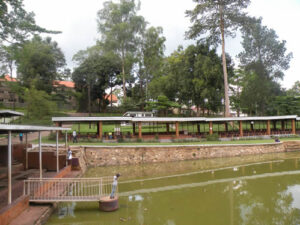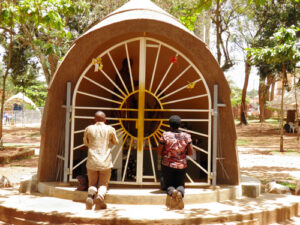The Uganda Martyrs were a group of young Christian and Muslim men who were killed between 1885 to 1887 because they chose to defend their faith. The men were executed under the orders of the Kabaka (King) Mwanga of Buganda. The original Catholic Uganda Martyrs were 22 in number but more 2 Christian men were killed in 1918 in a village called Paimol which is located in northern Uganda. This brings the total number of Catholic Uganda Martyrs to 24.
The two young Acholi Christian Martyrs from northern Uganda were persecuted in the hands of raiders. The two men were Daudi Okello, a catechist and Jildo Irwa who was his assistant. They were brutally  picked from their huts at midnight and speared to death. It is important to remember that other than the 22 Martyrs killed on the orders of Kabaka Mwanga, 23 were Anglican and a few Muslim.
picked from their huts at midnight and speared to death. It is important to remember that other than the 22 Martyrs killed on the orders of Kabaka Mwanga, 23 were Anglican and a few Muslim.
The majority of the Martyrs who were killed by Kabaka Mwanga were servants in his palace. Out of the 22 Roman Catholics he killed, 13 of them were burnt to death at Namugongo. Namugongo village was used as an execution ground for prisoners and all people who fell victim to the King’s anger. 9 of the remaining Roman Catholic Martyrs were killed from different locations.
What were the reasons why the Uganda Martyrs were killed? On 15th of November 1885, a man called Joseph Mukasa Balikuddembe who was the leader of the Christians at the King’s palace and one of the King’s advisors was killed because he had pleaded with Kabaka Mwanga to spare the life of Bishop James Hannington. Hannington was an Anglican missionary who had tried to enter the Buganda kingdom from its Eastern side. It was a taboo to enter the Buganda Kingdom from this direction and anyone who did so was believed to be an enemy of the Kingdom. Joseph Balikuddembe Mukasa was beheaded and then burnt at the Nakivubo swamp, a place that is currently located within center of Kampala City.
The major executions that occurred in Namugongo started on the 25th of May 1886 at the King’s royal enclosure in a place called Munyonyo, just at the shores of Lake Victoria. The King ordered the Christian men working for the Kingdom to abandon their Christian faith. When they refused, he became furious and sentenced them all to death. He started with Denis Ssebugwawo who was killed by a spear after  which another Martyr called Andrew Kaggwa was also killed on the same day. On the 26th of May, another Martyr called Pontian Ngondwe was killed by a spear from the hands of the palace chief executioner known as Mukajjanga. According to witnesses at the time, the corpse of Pontian was cut into several pieces and scattered in different directions at a place formerly called Ttabataba. The place was later renamed Ttakajjunge and is not so far away from Munyonyo. The following morning (which was the 27th of May 1886), one of the Martyrs called Athanasius Bazzekuketa volunteered to be killed at the same Mengo hill where his leader Joseph Balikuddembe Mukasa was earlier killed.
which another Martyr called Andrew Kaggwa was also killed on the same day. On the 26th of May, another Martyr called Pontian Ngondwe was killed by a spear from the hands of the palace chief executioner known as Mukajjanga. According to witnesses at the time, the corpse of Pontian was cut into several pieces and scattered in different directions at a place formerly called Ttabataba. The place was later renamed Ttakajjunge and is not so far away from Munyonyo. The following morning (which was the 27th of May 1886), one of the Martyrs called Athanasius Bazzekuketa volunteered to be killed at the same Mengo hill where his leader Joseph Balikuddembe Mukasa was earlier killed.
Several other Christians who refused to denounce their faith and working within the Kings palace were rounded up and forced to march towards Namugongo for their execution. The Martyrs of Uganda were tied to one another by slave yokes and chords on both their feet and necks. It is important to note once again that among the people forced to march for execution in Namugongo where Catholic Martyrs, 23 Anglicans and 6 prisoners who had been on death row for crimes not related to religion.
 Along the way to Namugongo from Mengo, a Martyr called Mathias Kalemba Mulumba refused to walk further when they arrived at old Kampala. He also requested to be executed right away and his wish was granted. The executioners picked him out of the group and cut off both of his hands, legs and some part of his back. The executioners applied herbs on his wounds to control the excessive bleeding but 3 days later he breathed his last due to thirst while left alone in the bush. The rest of the Martyrs continued to walk to the execution ground which was about 10 miles from where Mathias Kalemba was killed. As they were almost arriving at Namugongo, a Martyr known as Gonzaga Gonza was so worn out from the long trek and could hardly move anymore. He collapsed and was speared to death on the 27th of May 1886 at Lubawo hill around midday. You may want to read about the Uganda Martyrs Day Celebrations in Numogongo.
Along the way to Namugongo from Mengo, a Martyr called Mathias Kalemba Mulumba refused to walk further when they arrived at old Kampala. He also requested to be executed right away and his wish was granted. The executioners picked him out of the group and cut off both of his hands, legs and some part of his back. The executioners applied herbs on his wounds to control the excessive bleeding but 3 days later he breathed his last due to thirst while left alone in the bush. The rest of the Martyrs continued to walk to the execution ground which was about 10 miles from where Mathias Kalemba was killed. As they were almost arriving at Namugongo, a Martyr known as Gonzaga Gonza was so worn out from the long trek and could hardly move anymore. He collapsed and was speared to death on the 27th of May 1886 at Lubawo hill around midday. You may want to read about the Uganda Martyrs Day Celebrations in Numogongo.
The Killing of the Uganda Martyrs in Namugongo
The Uganda Martyrs finally arrived at Namugongo but were not killed immediately on arrival. They were instead confined for more 7 days while their executioners were organizing all the necessary supplies for the execution like adequate firewood and papyrus reeds. These preparations went on until the 2nd of June. The execution day eventually came and that was on the 3rd of June 1886. A traditional ritual had to first be performed before the mass killings begun. One Martyr by the names of Charles Lwanga was chosen for the ritual sacrifice and then taken away to a place which was about 50 yards from the main execution ground. He was permitted to organize for his own death by preparing a pyre made out of wood. Lwanga was wrapped in papyrus reeds and then placed on the pyre where he slowly burnt to death.
At around midday on the same day of 3rd June 1886, the rest of the Uganda Martyrs were burnt to death at Namugongo. The 12 men included Adolphus Mukasa Ludigo, Achilles Kiwanuka, Bruno Sserunkuma, Ambrose Kibuuka, James Kiriggwajjo, Mbaaga, Tuzinde, Mukasa Kiriwawanvu, Mugaaga and Kizito who  was a teenager and the youngest of them all. Kizito was later declared the patron saint for children in Uganda. It is important to note once again that the Catholic Martyrs were burnt together with other 23 Anglican Martyrs and 6 prisoners.
was a teenager and the youngest of them all. Kizito was later declared the patron saint for children in Uganda. It is important to note once again that the Catholic Martyrs were burnt together with other 23 Anglican Martyrs and 6 prisoners.
As earlier mentioned, the Uganda Martyrs were killed in two groups. The first are the ones who were killed in Namugongo and the second were those killed in other locations. The martyrs killed outside Namugongo were Joseph Balikuddembe Mukasa and Athanasius Bazzekuketa who were murdered at Nakivubo swamp. Denis Ssebugwawo and Andrew Kaggwa were murdered at Munyonyo. Mathias Kalemba Mulumba was murdered in old Kampala, Pontian Ngondwe in Ttakajjunge, Noa Mawagali at Kiyindi-Mityana, John Mary Muzeeyi at Mengo-Kisenyi and Gonzaga Gonza at Lubawo hill in Kamuli. You can also read about the Uganda Martyrs Shrine in Munyonyo.
What happened to the Uganda Martyrs Afterwards?
The Uganda Martyrs who were taken to Namugongo eventually died but their bodies did not turn into ashes. The executioners tried all their best to continue burning the corpses to ashes by continuing to fuel the fire but they couldn’t succeed so they eventually abandoned the site. The executioners had never experienced what they saw with the Martyrs. Their victims accepted to be killed willingly and sang songs of praise/worship even as they slowly burnt to death in the flames. Many of the executioners abandoned their execution roles for good. The execution ground was never used as a place for executing more people after the death of the Uganda Martyrs.
The corpses of the fallen martyrs were not buried by the executioners because there was a law that prohibited burying any persons that had been condemned to death by the King. The local people believed that such people were unworthy of decent burials and whoever was caught doing otherwise was charged with treason. About 6 months later, 3 Christians by names of Matayo (Mathew), Lewo (Leo) and Kirevu Bwaliri Kamya used the cover of darkness and sneaked into the forbidden killing ground. They collected the remains of Charles Lwanga who was the first victim of the killings and then took it to their spiritual  Father Simeon Lourdel. The priest cleaned and wrapped the remains in a red cloth, placed it in a copper box and then buried it in the sacristy of the church in Nabulagala. This church was later burnt down and abandoned due to the religious wars that had broken out in Buganda. The church site became a bush and the copper box could no longer be located. However, on the 13th of October 1893, the copper box was discovered by a Catechist while cultivating his land. The box was taken to Father Hirth in Tanganyika in 1899 because of political instability and later brought back by Henry Streicher who was the then Archbishop of Buganda. The remains of Charles Lwanga were kept at the Archbishop’s chapel until 1964 when it was taken to Rome for the ceremony of canonization. All the other Martyrs were also canonized and when the present day Namugongo Martyrs shrine was constructed, some of the relics of Charles Lwanga was brought back for veneration. His relics are still at the Uganda Martyrs Shrine in Namugongo and acts as a constant reminder of the bravery exhibited by the Uganda martyrs.
Father Simeon Lourdel. The priest cleaned and wrapped the remains in a red cloth, placed it in a copper box and then buried it in the sacristy of the church in Nabulagala. This church was later burnt down and abandoned due to the religious wars that had broken out in Buganda. The church site became a bush and the copper box could no longer be located. However, on the 13th of October 1893, the copper box was discovered by a Catechist while cultivating his land. The box was taken to Father Hirth in Tanganyika in 1899 because of political instability and later brought back by Henry Streicher who was the then Archbishop of Buganda. The remains of Charles Lwanga were kept at the Archbishop’s chapel until 1964 when it was taken to Rome for the ceremony of canonization. All the other Martyrs were also canonized and when the present day Namugongo Martyrs shrine was constructed, some of the relics of Charles Lwanga was brought back for veneration. His relics are still at the Uganda Martyrs Shrine in Namugongo and acts as a constant reminder of the bravery exhibited by the Uganda martyrs.

It’s an amazing story. Thanks for the information.
Thanks alot for enriching my knowledge about the Uganda martyrs. Be blessed.
Thank you for letting me know more about the Uganda Martyrs.
We pray that we be strong like the Martyrs. When you believe is God, you won’t feel pain but just feel the fresh breeze of heaven.
1 Peter 4:13. But rejoice in as much as you participate in the sufferings of Christ, so that you may be overjoyed when his glory is revealed.
WE SHALL MEET IN HEAVEN GENERALS.
Romans 8:35.
Then who will separate us from the love of Christ? Tribulation? Or anguish? Or famine? Or nakedness? Or peril? Or persecution? Or the sword? This is the true definition of Christianity.
This is a well researched story. Thank you.
Thank you for a very enriching write up. I was opportune to visit the Namugongo Church on Friday November 17 2023. I attended the 6:30 mass in the shrine where the relics of St. Charles Lwanga is buried.
Thank you for the information. Be Blessed.
Thank you for the information. I noted that the martyrs died because of their faith. Even Jesus died because of our sins and so we need to be faithful.
Thank you so much for the elaborate narration. I have enjoyed every detail of this emotional story. I wish you had also included a detailed narrative of those 23 Anglican Martyrs. God bless you.
Thank you so much for documenting in such detail what the Uganda Martyrs faced in the hands of the reigning monarch – the Kabaka of Buganda. It’s such a great history of the birth of the Christianity in Uganda, etched in the blood of the young martyrs. As we celebrate the Uganda Martyrs Day on the 3rd of June, we give God all the glory and honor.
I am so happy to know about the history behind the killing of the Uganda Martyrs. The story has taught me so many lessons and especially on the youngest who was Kizito Muto the patron saint.
PRAISE THE LIVING GOD. MAY THE LORD JUDGE THEM IN THE RIGHT WAY ON THE DAY OF JUDGEMENT.
Thank you for this historical useful information.
THIS WAS SO HELPFUL. THANKS AND BE BLESSED.
Thank you for making me understand why the Martyrs were killed.
I am very glad to learn this history. Thank You
Painful death but glory to God. Thank you for the detailed history of the Martyrs.
The Lord is Mighty and we will see them in Heaven, standing beside Him.
May the faith of the true Christians ( Uganda martyrs) strengthen the faith of young Christians today and forever.
If they were killed just because of the ceremonial laws of King Mwanga, Catholics could be the people to remember the moral of the ten commandments of God. However, they are lost when it comes to the fourth commandment which BIGINS with remember. Remember the Sabbath day to keep it HOLY.
Thank you so much for the story.
Thanks so much for the great spiritual history.